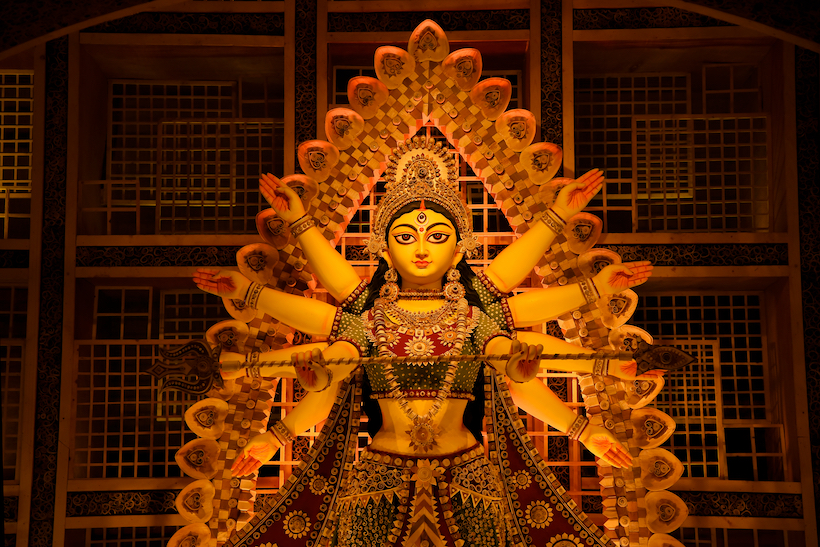
by Somya Devi | Sep 27, 2019 | Astrology, Conjunctions, Events, Holy Days, Planets Changing Signs
Tonight brings a dark Moon as the Moon joins the Sun in sidereal Virgo. Exact New Moon in Virgo will be at 11:26 am PT on Saturday, September 28th. This begins a Virgo cycle that will help us to connect with the earth, the feminine, and draw ourselves more inward as we enter the season of the Sun’s decent in the northern hemisphere.
Virgo Cycle
We’ve just passed the equinox on September 23rd, the time where night and day are of equal lengths, and we are now entering the yin season where the hours of darkness will exceed the hours of light. This first full lunar cycle begins in Virgo, a feminine earth sign, that encourages us to ground out some of the activity of summer and turn inwards as we come upon this darker season.
Virgo is also ruled by Mercury, the planet of the intellect, which will get us thinking about practicality and logistics this month. Have you planned your store for winter, getting together everything you need and tying up loose ends in the world before your period of inward attention and maybe even hybernation? Mercury is still technically joining the Sun and Moon in Virgo as we begin this cycle, but will be passing into Libra the next day. Venus and Mars also join in Virgo now, making our nights especially dark as these three stay close to the sun and only Jupiter and Saturn are visible. Venus remains debilitated in Virgo for just a few more days, until October 3rd.
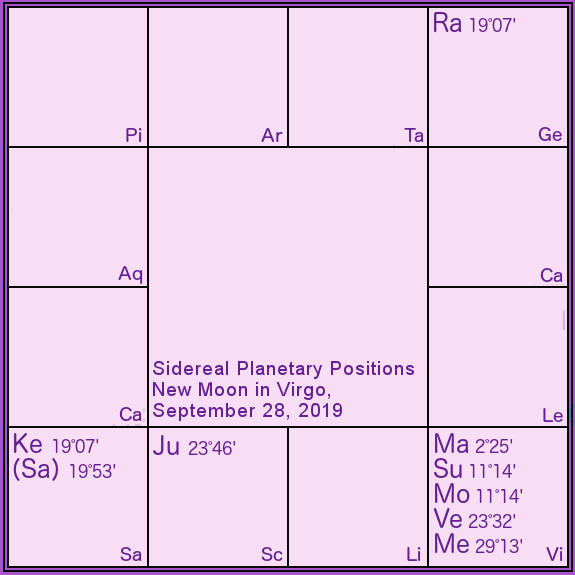
Hasta
This New Moon occurs with Sun and Moon in Hasta nakshatra, the sign of the hand. Hasta is a place that allows us to hone our skills, both manual and intellectual. It offers us a “craftiness,” whether literal, or of mind. This is a good time for getting into any hands-on work that requires dexterity, as well as for business dealings or other organization that requires tact and skill. Hasta is ruled by Savitar, the Sun God, while also linked to the Moon’s influence, and its animal is the female buffalo.
Maha Navaratri
The New Moon this month brings one of the largest Hindu festivals of the year, Maha Navaratri. Navaratri means “the nine nights,” and beginning with the first Moon phase after the dark Moon, the Goddess Devi is celebrated through many forms for the following nine nights and ten days. In North America Navaratri will be celebrated from September 29th through October 8th, with October 8th being the 10th day of Victory (an auspicious time for starting new endeavors, after 9 nights of worship). In some places Navaratri celebrates the goddess Durga in nine of her forms, while in other parts of India the festival commemorates Durga/Kali, Lakshmi, and Sarasvati for three nights each.
Devi is the creatrix, the warrioress, the nurturer, the purifyer, the protector. She can be found in the innocent and fertile maiden as well as the wise and learned crone. She is both the nurturing mother, and the one who gives “tough love.” The impassioned lover, the devoted bhakta, the disciplined yogini. We see Devi appear through us in innumerable manifestations. Through her many forms, she teaches us and offers us countless blessings–love, compassion, courage, learning, discipline, surrender, success, enlightenment, and bliss.
This festival is a time for honoring and celebrating the supreme feminine power in all her glory, and the many blessings she bestows upon us. Read more about Maha Navaratri 2019 here, and stay tuned for daily updates on how to connect with the many forms of the Goddess.
Kala Sarpa & Nodal Influences
This year’s festival could churn up even more internal difficulties than usual … offer them to the Goddess! We are currently under a Kala Sarpa cycle, with all planets to one side of the Rahu-Ketu axis, and will be in this alignment until October 6th. This can bring up more shadow energy and sticky spots than usual, especially if you are running a Rahu-Ketu dasha or have these planets prominently in your chart. It’s all the more reason to join the festivities and offer worship or some kind of spiritual practice during these days.
The good news on the nodal front — Saturn and Ketu will finally be separating a bit, and will leave their 1-degree proximity on October 1st! With Mean Node calculations, Ketu and Saturn have been joined within one degree of each other since April 25th! This will begin to slowly take some pressure off in the area of your life shown by Sagittarius, or those ruled by Saturn.

by Somya Devi | Apr 3, 2019 | Astrology, Conjunctions, Eclipses, Events, Holy Days, Planets Changing Signs, Retrograde
The Sun and Moon come together to begin a new lunar cycle at 1:51 am PDT on April 5th. They will join in sidereal Pisces in the nakshatra called Revati, the last of the 27 star signs of Jyotish. This New Moon brings with it the springtime nine-night celebration of the goddess, known as Chaitra Navaratri. Though often less celebrated than the fall-time equivalent, this holiday is an important counterpart as we recognize the blooming of the life cycle, made possible by the sacred divine feminine.
Pisces Cycle
The Dark Moon will be in sidereal Pisces, at 21°. (If you aren’t familiar with the sidereal/star-based vs. tropical/seasonally-based zodiacs, review my article here!) Pisces is the last of the twelve major signs, and thus relates very much with letting go, especially on the materially plane, and surrendering to spirit or a higher power. Ruled by Jupiter (literally “Guru” or the teacher), the Pisces cycle will help us to get more in touch with our highest values and philosophies. As a water sign, we are also more intuitively driven this month. Your dreams and visions can reveal a lot during this cycle, and inward reflection and meditation can be potent on this Dark Moon (April 4th-5th).
Revati
In addition to being in the final rasi, this New Moon is also in the final nakshatra, the Vedic signs that the Moon visits for one moon phase each, each month. Meaning “the wealthy,” this sign brings grace, kindness, and compassion. It is ruled by the deity Pushan, the celestial shepherd who provides nourishment and protection, both to herds (of animals) and also to people on safe journeys. This star often brings a love of animals and people with a natal Moon here often work with animals or have strong relationships with pets. The actual animal symbol is the female elephant, another auspicious symbol in India.
 Chaitra Navaratri
Chaitra Navaratri
After the Dark Moon night, the first nine nights of this cycle will be the springtime Navaratri celebration, in the Hindu month of Chaitra. The nine nights are a time to get in touch with the Goddess energy, apparent and emergent as we enter the spring season in the northern hemisphere. There are so many forms to the goddess, and she truly offers us an immense well of abundance through all facets of life. This is a good time to get clear on what you are calling in, and trying to manifest with the grace of the goddess by your side.
Recent Nodal Transit
The nodes on all counts are officially transiting Gemini and Sagittarius now, with Rahu in Gemini and Ketu in Sagittarius. This new nodal cycle will last until September of 2020. Whichever houses these are in your chart will be effected, especially around the times of the eclipses, this July, December-January, and next June-July.
Saturn & Ketu
Not only is Ketu in Sagittarius, but he is approaching a close conjunction with Saturn. This could pile up a lot of stressful energy in the area of your life indicated by Sagittarius, unfortunately for most of this year. They’ll be joining within one degree (mean node calculation) at the end of this month, on the 25th, as Saturn slows to a halt and begins retrograde motion on the 29th. Since Ketu is always “retrograde,” the two will then be traveling together through the whole summer, until Saturn turns direct on September 18th, and they finally break their one-degree proximity on October 1st.
How will this affect us? It’s difficult to say exactly because they have somewhat conflicting energies… thus you can expect to feel this type of push-pull conflict in the Sagittarius area of your life. Saturn puts on the pressure, makes us do the hard work to meet our goals, have patience, and endure. On the other hand, Ketu often compels us to throw our hands up and renounce the task at hand, feeling so critical of it that we often want to let it go completely. We can dive into an exploration of this transit over your personal chart in an Eclipse Reading.*
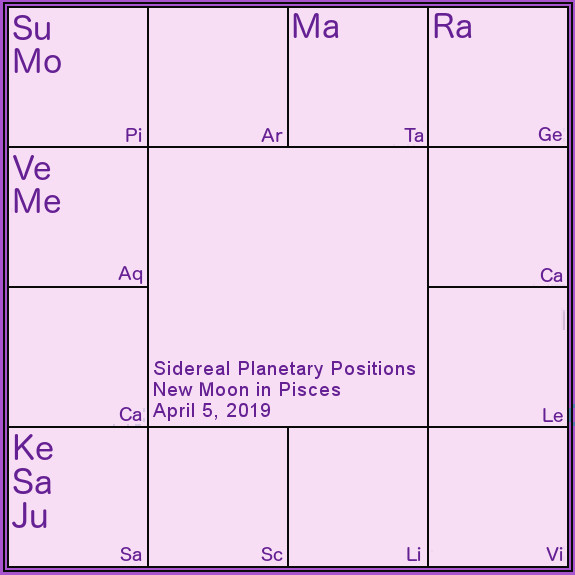
Jupiter & Venus
Jupiter is also joining Saturn and Ketu in Sagittarius now, hovering in the early gandanta degree as he slows to a stop and begins retrograde motion on April 10th. This will send him back into Scorpio on the 22nd. His presence in his own sign of Sagittarius could normally be uplifting to the situation there, but in his current condition he may not be as helpful as usual. The gandanta energy could make him weaker, while the retrograde condition is actually a strength (he will be quite bright in the sky in the coming months). Remember that he is also the ruler of this Pisces new Moon, so this “mixed” stuck/inspired energy could also seep into the general tone of the month ahead.
Venus will be moving into Pisces on the 15th, however, where he is exalted, which could bring some upliftment and more happiness into our lives, though he will also be conditioned by the mixed opportunities that Pisces’ ruler Jupiter offers right now.
*If this is your first reading with me, I recommend starting with the longer life-course reading, which will include a look at the current transits and how these affect you, in addition to your general karma, strengths, and challenges.
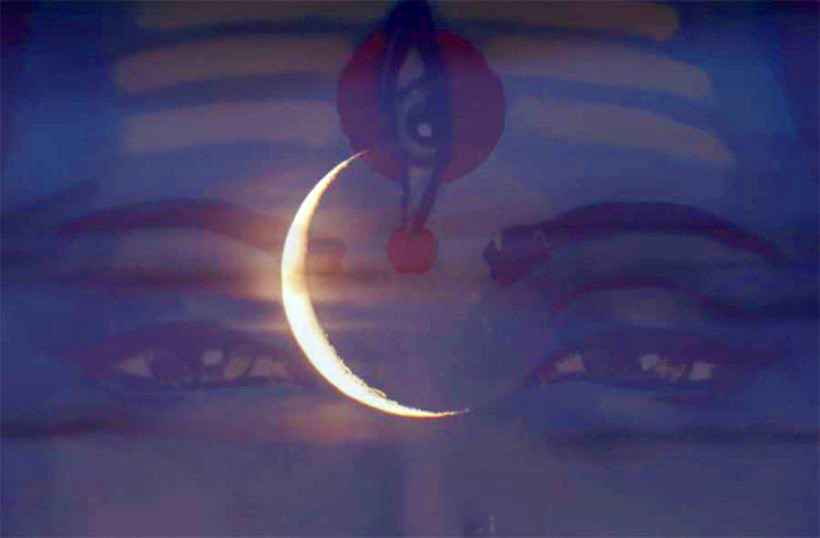
by Somya Devi | Feb 28, 2019 | Astrology, Conjunctions, Holy Days, Planets Changing Signs, Retrograde
The Moon wanes in sidereal Aquarius on the dark night of March 5th, approaching the exact Sun-Moon alignment for a New Moon at 8:04 am on Wednesday, March 6th, beginning a new lunar cycle. Leading up to this will be Maha Shivaratri, “the great night of Lord Shiva,” on March 4th. This is an auspicious night for prayer and penance, and the benefits of sadhana are multiplied by the Moon’s position and the collective vibration.
Maha Shivaratri
Monday night, March 4th, the night prior to the Dark Moon night, is the fourteenth waning phase of the lunar cycle. During this month this night is celebrated as Maha Shivaratri. This is perhaps the most auspicious night of the year for doing sadhana (spiritual practice). It is traditional on this night to stay up all night fasting, chanting, praying, and meditating. This holiday honors Lord Shiva, the great ascetic, and we can recall two stories of great sacrifices that he made protect the entire creation.
One of these is the story of the churning of the milk ocean, which the gods and demons were doing in order to release the nectar of immortality. Before the nectar came up, however, a poison came up first. (This is similar to when we do spiritual practice and begin our path of self-inquiry, and negative tendencies often come to light first, which can be a painful experience. Similarly, during a physical fast or cleanse, toxins can be shaken loose and released first, causing a healing crisis before we continue healing into a freer, happier state of being.) When the poison came up from the milk ocean, Lord Shiva consumed it so that it would not engulf humanity, as a great and noble sacrifice. His wife, Parvati, however, held his throat so that he could not ingest it, thus saving him from being harmed by the poison.
Maha Shivaratri also commemorates the wedding of Shiva and Parvati, which also stemmed from great sacrifice made for the benefit of all humanity. It was said that after his first wife, Sati, perished, Shiva was fully devoted only to his sadhana, meditating for aeons in isolation and renouncing the world. Then the demon Tarakasura began running amock on earth, threatening all of humanity. Brahma foretold that only Shiva’s child could defeat Tarakasura, so the gods devised a plan for Sati to reincarnate as Parvati, and win over her Lord to marriage once again. He was not easily swayed, however, and it was only after Parvati became an ascetic and underwent great penance that he agreed to marry. They eventually produced their son Kartikkeya, who went on to slay the demon.
Thus, this holiday is celebrated through the penance of fasting, forgoing food, water, and sleep, for one night, and simultaneously celebrating the union of Lord Shiva and Parvati, or the masculine and feminine energies of creation, that allows this dance of life to continue. It is an apt time to feel the forces of Aquarius upon us, which compel us to consider our role in society, and in the universe, and what personal sacrifices we can make for the greater good. Even if you’re not able to stay up the whole night, any amount of devotional practice, serviceful sacrifice, or chanting of Om Namah Shivaya on this night can have beneficial affects that are magnified greater than on any other night.
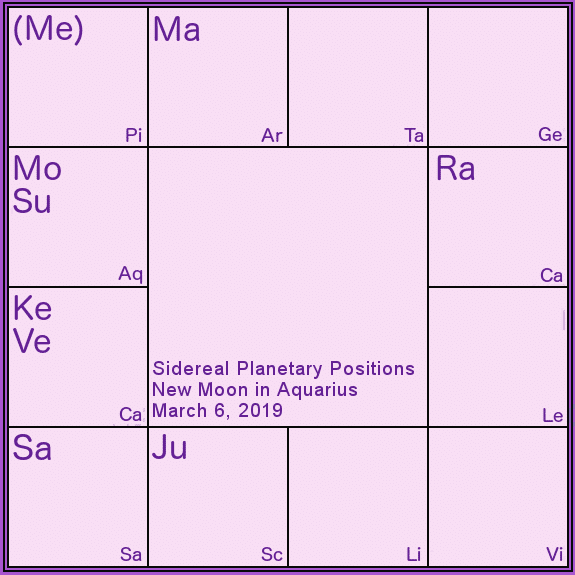
Aquarius Moon Cycle
The Sun and Moon meet in sidereal Aquarius to begin this lunar cycle. Aquarius is known as Kumbha in Sanskrit, a word for “pitcher” or “vessel.” According to the Vedic texts, the sign Kumbha can be imagined as a man holding a pot, with deep-brown skin, standing in the water. We can see this Aquarian imagery in the sadhus of India (and its biggest ritual pilgrimage day, the Kumbha Mela), who make their lives an offering of service to society through their prayers and Saturnian austerities, while renouncing the individual self. In the Aquarius cycle, we think about how we can serve the whole.
Saturn both rules Aquarius and is aspecting the Sun and Moon here (from sidereal Sagittarius) at the time of this New Moon. Saturn brings to us awareness of the long term and the bigger picture, and through this masculine or active sign, compels us to make commitments and offerings to something greater than ourselves and our momentary happiness. This is a great month to consider a new way that you may be of service to your community or to society.
Purva Bhadrapada
The New Moon cycle begins with the Sun and Moon in the Vedic nakshatra called Purva Bhadrapada, the former “lucky footed one.” This nakshatra bridges Aquarius and Pisces and is often represented by a funeral cot, symbolizing the transition from life into death, or ultimate liberation. It is ruled by Aja Epakada, the one-footed goat who is often associated with the image of Lord Shiva as Nataraj dancing on one foot, a fitting image for Maha Shivaratri.
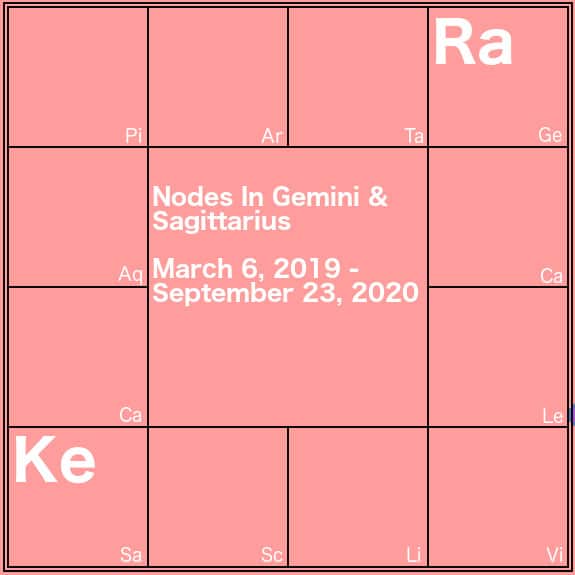 Nodes Are Changing Signs!
Nodes Are Changing Signs!
With a mean node calculation, Rahu and Ketu will transit into Gemini-Sagittarius on March 6th. (Under a true node calculation, they will not change signs until March 23rd; See Technicalities: Mean vs. True Node section below if you want a little more info about nodal calculations.) Regardless of the calculation used, March is a month of transition for the nodal energy. With the nodes in Cancer-Capricorn for the last year-and-a-half, we collectively felt a dichotomy between listening to the heart and following our emotions, against doing what is practical and responsible in an earthly way. It was a chance to balance these two things as well, learning to create a harmony between the practical and the emotional.
Throughout the coming transit of Rahu and Ketu through Gemini and Sagittarius, we will be feeling a polarization between curiosity, fact-finding and learning in an intellectual way, versus taking actions based on our principles and beliefs. Sometimes the intellectual mind does not agree with our fiery passions. This transit will be a time to learn to balance the two. With opinionated Sagittarius on one side, and communicative yet flexible Gemini on the other side, we may learn new ways to communicate and interact with those who oppose us in ideas, stepping into another’s shoes while still maintaining and honoring our personal beliefs and philosophy.
For each natal rising sign, this coming transit will affect a particular axis of learning in your life. You will be more able to see and work with some of your blind spots in these areas throughout the coming year-and-a-half long nodal transit. These things will especially surface around the bi-annual pairs of eclipses (coming this year in July and December).
Mercury Retrograde
Mercury stations and begins apparent retrograde motion on March 5th, the day before the New Moon. He is also currently debilitated in sidereal Pisces, so this time period could have us a bit mixed up around some details, and possibly challenged with communication and accuracy. He’ll retrograde back into Aquarius on March 14th, before returning to direct motion on the 28th.
Jupiter Gandanta
Also during the first half of this lunar cycle, Jupiter will enter the last 48 minutes of sidereal Scorpio (one muhurta), on March 15th. This region of the sky, called gandanta or a “knot,” is considered one of the most difficult places in the zodiac. It spans for one muhurta before and after the 0° point between sidereal Scorpio and Sagittarius, as well as those regions on the cusp of Cancer-Leo and Pisces-Aries (however, this gandanta location is often considered the most difficult. (Some astrologers may consider it spanning up to one or even two or three degrees to either side of the cusps.)
Normally, a planet transits through this zone rather quickly. Jupiter is currently slowing down, however, and will come to a stationary halt at 0°14’ of sidereal Sagittarius on April 10th, before beginning retrograde motion and passing back into Scorpio. He will threrefore be traveling the gandanta zone all the way from March 15th until May 6th (or longer if the zone is interpreted as wider).
Though Jupiter will be dipping into his own sign from March 15th through April 22nd, the fact that he will remain in gandanta at this time will not bring the added strength that we would expect from a sva graha. Those who are ruled by Jupiter may feel a bit “stuck” in various ways throughout this transit. It is important to be patient and keep up with sadhana during this time. Additionally, he will be joined by both Saturn and Ketu during his time in Sagittarius, both of which can be challenging companions.
Technicalities: Mean vs. True Node
Rahu and Ketu have been transiting through the Cancer-Capricorn axis for nearly 18 months, and are getting ready to make their transition into the Gemini-Sagittarius axis, for the next 18. The date of this transition will vary whether you are using the “mean node” calculation or the “true node” calculation. To simplify this as much as possible, we must realize that the nodes do not have planetary bodies that can be observed as the other grahas can be. (The grahas are “the forces that grab us,” including the Sun, Moon, Mars, Mercury, Jupiter, Venus, Saturn, Rahu and Ketu.)
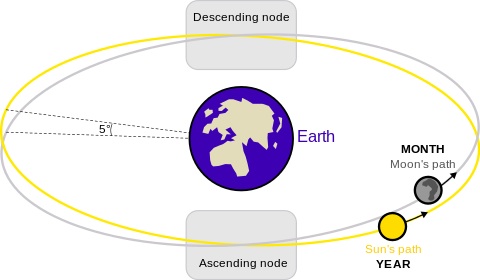 The nodes, astronomically are the places where the Sun’s and Moon’s paths intersect. The ecliptic is the apparent paths that the Sun travels “around” the Earth. The Moon’s orbits is not completely flat or parallel with the Sun’s, but slightly inclined, so that it passes this line and is sometimes to the north of it, sometimes to the south. We can measure astronomically and by observation when these crossings happen. To get the mean node, we take an average distance between these two points based on how many days it takes the Moon to get from one to the other. The true node is calculated using a method that also accounts for the slight wobble of the earth and the Moon’s orbit around it.
The nodes, astronomically are the places where the Sun’s and Moon’s paths intersect. The ecliptic is the apparent paths that the Sun travels “around” the Earth. The Moon’s orbits is not completely flat or parallel with the Sun’s, but slightly inclined, so that it passes this line and is sometimes to the north of it, sometimes to the south. We can measure astronomically and by observation when these crossings happen. To get the mean node, we take an average distance between these two points based on how many days it takes the Moon to get from one to the other. The true node is calculated using a method that also accounts for the slight wobble of the earth and the Moon’s orbit around it.
Some astrologers favor using the “mean” node calculation while others prefer the “true.” These two calculations of the node will sometimes put them about one degree apart, which is noticeable in cases where, in a natal chart, someone’s node is on the cusp of two signs (it may be in one sign using mean node and another sign using true node). It also affects the date of transition between signs that we observe when talking about nodal transits. In both cases, it is best to observe for yourself (use a lot of charts for case studies) and see which makes the most sense to you. I prefer using mean node calculation.
Personal Readings are available to help you understand your individual natal chart and how these transits will affect your upcoming year.
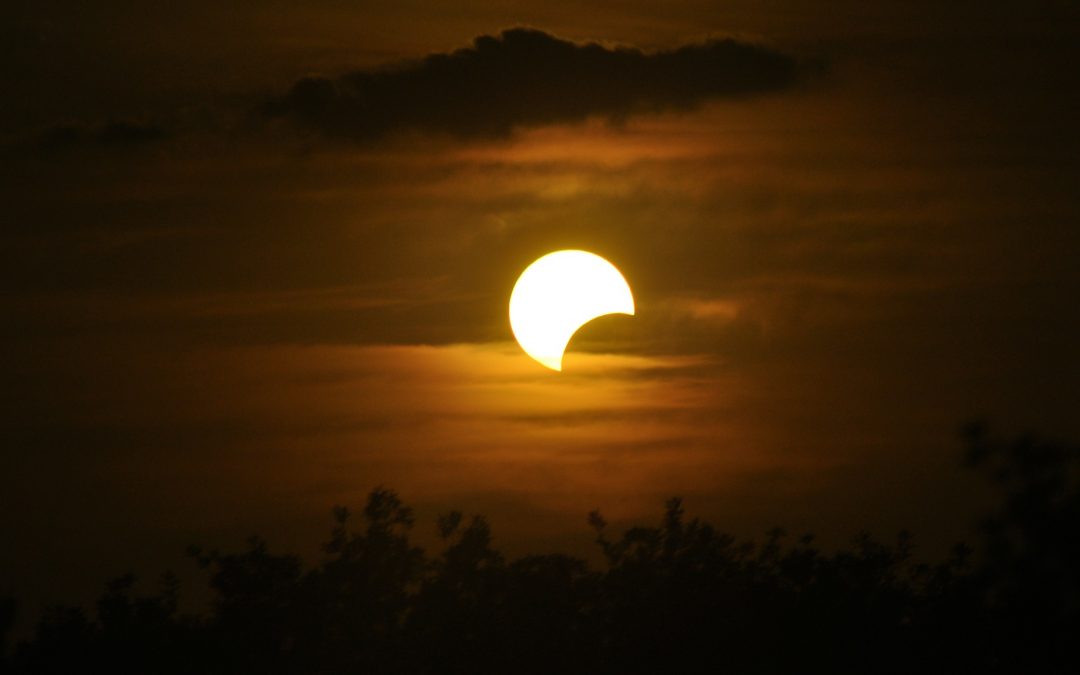
by Somya Devi | Jan 3, 2019 | Astrology, Conjunctions, Eclipses
The Moon is waning towards total darkness and will reach exact conjunction with the Sun for the “New Moon” moment on Saturday, January 5th, 2019, at 5:28 pm PST. The Sun and Moon will join at 21° sidereal Sagittarius, aligned closely with the center of the Milky Way galaxy, in Purva Ashada nakshatra. The Sun and Moon will be in close enough proximity with Ketu (at 3° sidereal Capricorn), to bring about the first eclipse of the year. The partial solar eclipse will occur over eastern Asia and the Pacific, reaching its maximum at 5:41 pm PST, and visible from eastern China, Mongolia, and Russia, as well as Japan, the Korean peninsula, and southwestern Alaska.
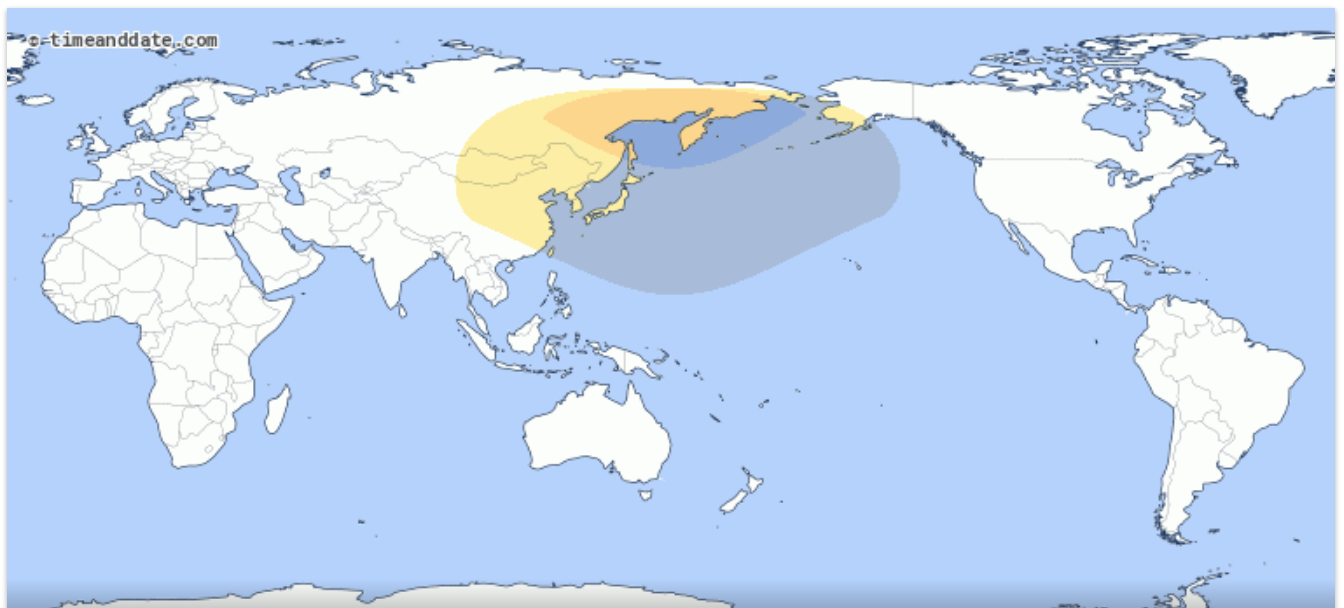
Sagittarius
This new Moon solar eclipse will occur in sidereal Sagittarius, setting the tone for the coming month with a Sagittarian mood. Sagittarius is an active fire sign ruled by Jupiter, the planet of principles and beliefs. This new Moon will bring forward a healthy dose of principles and opinions, but with the Sun partially blocked by the Moon’s shadow, we may feel overly emotional about these and at the same time, lacking the power to do anything. (You can also relate that sentiment with the area of life mentioned in the Forecast section below). Within Purva Ashada nakshatra, however, we may find more courage from within than seems readily at hand.
Purva Ashada
This nakshatra spans from 13°20′ to 26°40’ of sidereal Sagittarius, and means the former “invincible” or “unconquered.” It is ruled by Apah (or Apas), the water goddess. Its animal symbol is the male monkey, which brings a playful energy here. Its planetary ruler is Venus and thus also has associations with goddess Lakshmi. The three stars that make up this nakshatra in the night sky take the shape of a fan, and the fan is another symbol for this asterism.
Under its invincible nature, the Purva Ashada new moon is a powerful time to find our courage, despite the feelings of limitation that can be brought on by a solar eclipse. Through the symbol of the fan, we can see one who is adorned in luxury, or one who may hide behind a fan in humility or mystery, but there is a great power that can be hiding there, especially feminine power. The fan can be used to sustain us under pressure, bringing a cooling breeze that feels like the grace of god when the world gets too hot. Though our power may feel hidden, it is there to be tapped into with focus and dedication.
Saturn and Mercury
Saturn and Mercury both join this new Moon in Sagittarius. Saturn is going to have an even stronger role in our lives than usual in 2019, as he will be joining Ketu in close conjunction, within one degree, for over five months. Saturn in Sagittarius can help us to have not only the courage to do what we believe is right, but the stamina and dedication to get it done. Though we may feel a bit muddled by the eclipse (and the current combust nature of Saturn, so close to the Sun), Saturn’s determination will reveal himself more as the month goes on.
There will be a planetary war, however, between Saturn and Mercury, on the 12th and 13th of this month, when the two come within one degree of each other. When two planets are at war, contending for our attention in the same part of the sky, both will suffer, and the things they represent. With Mercury at war, our intellects will not feel as sharp, and it may be hard to pay attention to details or communicate clearly on these days. With Saturn at war, keeping our eye on long-term goals may be hard, and we may feel temporarily deflated and struggle at work. The four areas in your chart ruled by Saturn and Mercury may also suffer, or feel at odds with each other, during this time.
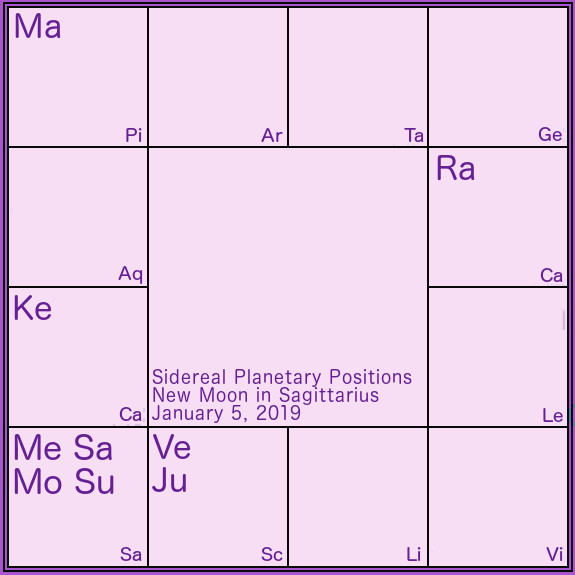
The Solar Eclipse
Though the eclipse may not be visible where you are, its effects are still tangible, and things are probably already gearing up with intensity in the area of your life indicated by Sagittarius. Though Rahu and Ketu are still in Cancer and Capricorn (since August of 2017), they are coming very close to transiting into Sagittarius and Gemini (which will happen in March), and this eclipse is giving us a taste of what is to come during the next nodal transit and the eclipses to occur in 2019 and 2020.
Forecast
Here are a few of the areas where challenges may be occurring due to this eclipse (and where you need to do the work), based on your Vedic rising sign (there can also be others, when examined specifically, or in a personal natal chart analysis):
Aries — education, faith, foreign travels
Taurus — sudden changes, upheaval, secrets coming to light
Gemini — partnerships, love, business relationships
Cancer — health issues, disputes, litigation, pets
Leo — children, wisdom, authority
Virgo — the heart, the mind, home, mother
Libra — siblings, will, skills
Scorpio — the family, wealth, the mouth
Sagittarius — self-identity, place in the world
Capricorn — loss, loneliness
Aquarius — community, friends, income
Pisces — career, social status
Please join me and my fellow astrologers on January 25th for the 2019 Jyotish Transit Summit Webinar. The webinar is free, and you can register through this link.

by Somya Devi | Nov 21, 2018 | Astrology, Conjunctions, Retrograde
Full Moon in Taurus
The Moon is waxing towards its brightest point, to align fully opposite the Sun for a full Moon in Taurus at 9:39 pm PST on Thanksgiving night, Thursday, November 22nd. The Moon will be in its sign of exaltation in early sidereal Taurus, in the Vedic nakshatra of Krittika, opposite the Sun in Scorpio. Mars, Jupiter and a retrograde Mercury all aspect this full Moon, while Venus rules over it in Taurus. With the Moon and the mind happy and grounded in this fertile earth sign, this is truly a fitting time to let the heart settle and give thanks for what is.
Exaltation in Taurus
We began this lunar cycle with the Moon dark and approaching debilitation, on November 7th. The Moon is fully “debilitated” in the third degree of Scorpio (although Sun & Moon conjoined to begin this cycle near the end of Libra). In the passionate water sign of Scorpio, the mind becomes aware of its most sensitive points, and can go through turbulent emotions as it rides the waves under Mars’ rulership.
Moon is considered “exalted” in the opposite sign of Taurus, where we find this week’s full Moon. Taurus is an earth sign ruled by Venus. The earth element helps our minds and hearts to find more stability and become grounded, and our emotions are less likely to be tossed about by external forces. Taurus is ruled by Venus, the planet that ultimately helps us to find ways to be happy, so there is a natural inclination towards seeing the beauty and harmony of life when the Moon is here.
Venus is still transiting his own sign of Libra, and getting gradually stronger as he picks up speed after six weeks in retrograde motion. (Though feminine in nature, Venus, like all planets in Jyotish, gains a masculine pronoun when personified.) Venus helps the mind to be happy when the Moon is under his rule, because Venus drives us towards pleasure and happiness, and helps us to look for and see beauty. This is a great outlook for approaching the Thanksgiving holiday, especially when difficult family dynamics may be present. On this holiday where there is a tendency to overindulge in consumable pleasures, however, be especially mindful this year, as Venus (and Jupiter) could help to push that to extremes.
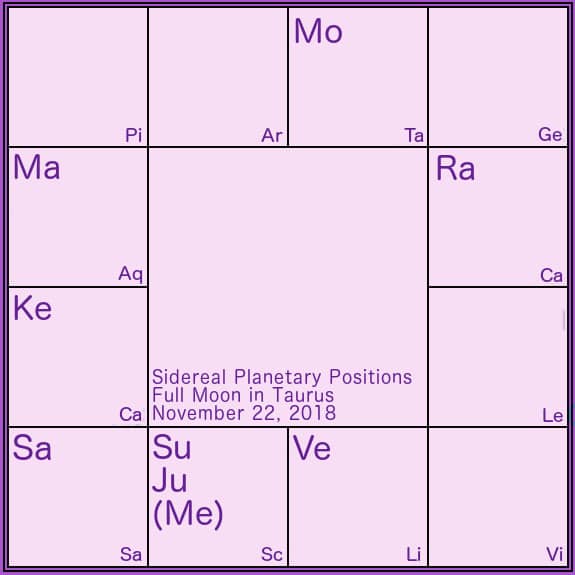
Krittika Nakshatra
Within the Vedic system, Krittika nakshatra spans from 26°40′ Aries to 10° Taurus. This star-sign is known as “the cutter” and is represented by an axe, a razor blade, or a flame. Agni, the Lord of Fire, rules here, and his sharp and transforming nature drive the energy of this nakshatra. Though we are experiencing the beauty-seeking nature of Venus, we are also receiving the purifying and sattvic influence of the Sun, who rules this nakshatra, while the Moon transits here.
This nakshatra can be located in the sky as the cluster of seven stars also known as the Pleiades. In Vedic mythology, these correlate with the wives of the seven sages who found and nursed the baby Kartikeya, the son that Shiva and Parvati birthed through the vehicle of the river Ganga. There is a maternal and nurturing quality to this star, in addition to its power to help us to cut through the unnecessary in our processes of purification. Fittingly, the Indian saint “Amma” (Amritanandamayi) was born under Krittika nakshatra, and demonstrates these qualities of being a nurturing mother to all as well as a powerful sattvic purifier.
Aspects: Mars, Jupiter & Retrograde Mercury
In addition to full illumination from the Sun, this full Moon is also receiving light and energy from Mars, Jupiter, and Mercury (though Jupiter is quite combust, within three degrees of the Sun). Mars’ influence can stimulate the mind into a more rajasic state, and can add a bit of heat and tension. With Mercury also in retrograde motion, be very aware around getting into arguments or trying to explain (or re-explain) your point of view to others. Though Jupiter sends some benefic and inspiring influence, the loftiness of your ideas may be burned up and lost as you attempt to communicate from a philosophical or idealistic place. Mercury will continue in retrograde motion through the next New Moon, on December 6th.














